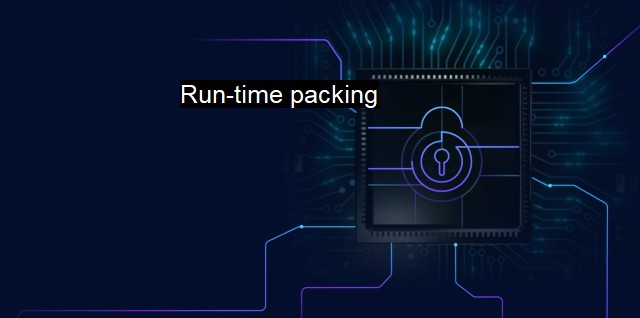What is Run-time packing?
Run-Time Packing: A Sneaky Tactic Employed by Malware Authors to Outsmart Antivirus Protections
Run-time packing is a term used within the context of cybersecurity and antivirus science, referring to a sophisticated method by which malicious software, or malware, attempts to hide its real code to bypass security systems. Unfortunately, run-time packing has emerged as a significant challenge expanding the realm of threats by allowing malware to circumvent detection by conventional security measures. To understand this concept, let's delve into its mechanics, usage and the strategies that have been developed in response.The process of run-time packing involves the compression or encryption of a piece of software's original code, including the payload (or malicious part of the code). This compressed or encrypted code is then injected with a specific routine that unpacks or decrypts this code in memory at run-time - hence the term. Once the software is launched for execution, this packing code executes first, unpacks the actual code and proceeds to execute it. In layman's terms, it’s like a wrapped gift where the wrapping paper (the packing code) needs to be removed first to reveal the actual gift (the packed code).
Packers were originally developed with benign intentions, as developers used them to reduce the size of their software or protect their intellectual property by hindering reverse engineering. malicious actors quickly adopted this technology to evade antivirus scanners.
Most traditional antivirus systems rely on static analysis of code to detect potential threats. Static analysis includes examining the code without executing it and inspecting for known malicious signatures. But when the code is packed, it becomes difficult for antivirus programs to examine it and hence complicates the detection process. As the code is compressed or encrypted, the malware's signature is concealed, rendering static analysis procedures useless in identifying the threat.
Now, the landscape of run-time packing encapsulates a wide range of techniques. It could be as straightforward as a simple compression algorithm or as tricky as encryption followed by several execution layers and could even include polymorphism, where the packer produces a different hash value each time the malware is run to avoid hash-based scanning. In extreme cases, advanced packers can employ rootkit technology to cover the unpacking and execution process of the malware, hence leaving barely any trace for security systems to detect.
The cybersecurity community, well aware of this challenge, has taken proactive measures. One such strategy is to conduct dynamic analysis or code execution in a controlled, sanitized environment (also known as a sandbox) and monitor the software's behavior. In principle, regardless of how well a malware is packed, eventually, at run-time, it needs to reveal itself in memory. By studying the software's behavior in a secure environment, antivirus systems can pinpoint suspicious actions that demonstrate malware presence.
Another noteworthy strategy involves data mining and machine learning tools that are willing to use advanced detection models. Such systems go beyond relying merely on signatures and rather leverage algorithms that can recognize patterns indicative of a potential threat.
In any case, run-time packing is a serious concern for cybersecurity and antivirus researchers. The continuous development of packing techniques signifies an ongoing contest between malware creators and cybersecurity experts. It's crucial to stay informed about and develop robust tools that can adapt quickly to the latest packing methods. It clearly reflects that identifying and countering future iterations of malware will be heavily reliant on proactive defense strategies, advanced mechanisms, and innovative implementations.

Run-time packing FAQs
What is run-time packing in cybersecurity?
Run-time packing is a technique used in cybersecurity to obfuscate code and make it more difficult for antivirus programs to detect malware. It involves compressing and encrypting executable code at runtime, making it more difficult to analyze and detect.Why do cybercriminals use run-time packing?
Cybercriminals use run-time packing to evade detection by antivirus programs. By compressing and encrypting their malware at runtime, they can make it more difficult for antivirus programs to detect and remove it from infected systems.How do antivirus programs deal with run-time packing?
Antivirus programs use various techniques to detect and analyze run-time packed malware. They may use heuristics to identify patterns in the code that are consistent with run-time packing, or they may use behavioral analysis to detect suspicious activities related to the malware. Some antivirus programs also use sandboxing techniques to analyze the malware in a controlled environment.Is run-time packing always used for malicious purposes?
No, run-time packing is not always used for malicious purposes. It can also be used for legitimate purposes such as software protection. Some software vendors use run-time packing to prevent reverse engineering and software piracy, by encrypting their code and making it more difficult to analyze and modify.| | A | | | B | | | C | | | D | | | E | | | F | | | G | | | H | | | I | | | J | | | K | | | L | | | M | |
| | N | | | O | | | P | | | Q | | | R | | | S | | | T | | | U | | | V | | | W | | | X | | | Y | | | Z | |
| | 1 | | | 2 | | | 3 | | | 4 | | | 7 | | | 8 | | |||||||